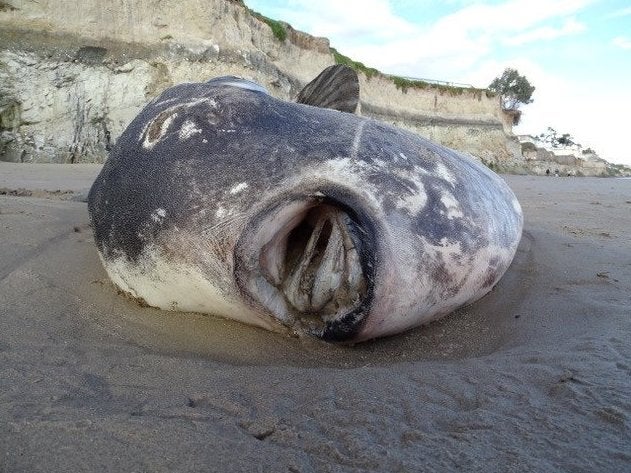Rare giant sunfish washes up in northern hemisphere for first time in 130 years
'I literally, nearly fell off my chair,' says scientist who identified species

Your support helps us to tell the story
This election is still a dead heat, according to most polls. In a fight with such wafer-thin margins, we need reporters on the ground talking to the people Trump and Harris are courting. Your support allows us to keep sending journalists to the story.
The Independent is trusted by 27 million Americans from across the entire political spectrum every month. Unlike many other quality news outlets, we choose not to lock you out of our reporting and analysis with paywalls. But quality journalism must still be paid for.
Help us keep bring these critical stories to light. Your support makes all the difference.
A rare seven-foot sunfish has been found washed ashore in California, stunning the scientist who identified its species.
The hoodwinker sunfish has not been seen in northern hemisphere waters in around 130 years.
It was identified in 2017 and is thought to live in the southern hemisphere.
An intern at the University of California, Santa Barbara (UCSB) first spotted a stranded sea creature last week at Sands Beach, in the institution's Coal Oil Point Natural Reserve.
The intern alerted Jessica Nielsen, a conservation specialist at Coal Oil Point, who initially thought the fish was an example of a local species and posted photos of the creature on Facebook.
Her post caught the eye of Thomas Turner, an associate professor at UCSB, who in turn visited the creature and posted photos to iNaturalist, a scientific online community.
Eventually the images came to the attention of Marianne Nyegaard of Murdoch University in Australia.
Ms Nyegaard identified the hoodwinker sunfish species in 2017 and formally named it Mola tecta.
The species was nicknamed “hoodwinker” because of how long it had taken for it to be identified.
The scientist was at first unsure if the sunfish was a hoodwinker, as it was so far out of its known range.
A hoodwinker sunfish was last seen in the northern hemisphere around 1890, in the Netherlands, according to Ms Nyegaard's research.
She told Ms Nielsen and Mr Turner to send her more photographs and to take tissue samples.
The tide had moved the sunfish several hundred yards from its original position but the pair eventually found the creature.
Ms Nyegaard said she ended up with a large number of extremely clear photos “and there was just no doubt of the ID.”
“I literally, nearly fell off my chair,” she told UCSB's The Current of her reaction to the images.
It is unclear how the sunfish ended up thousands of miles away from its native waters.
Additional reporting by agencies
Subscribe to Independent Premium to bookmark this article
Want to bookmark your favourite articles and stories to read or reference later? Start your Independent Premium subscription today.
Join our commenting forum
Join thought-provoking conversations, follow other Independent readers and see their replies
Comments